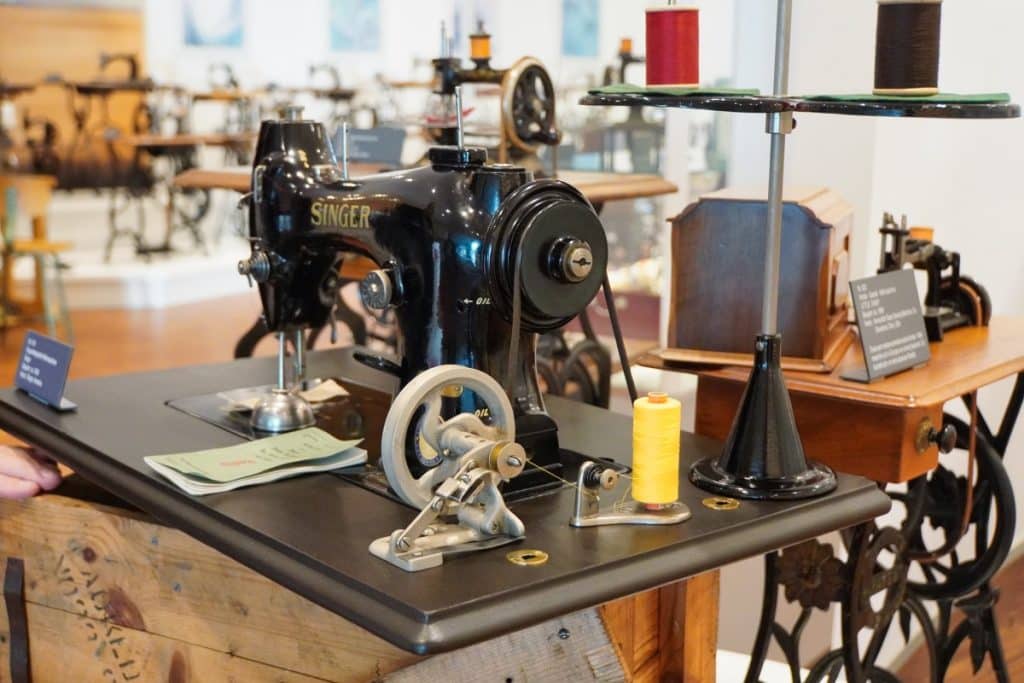Albstadt is a textile town. As early as the middle of the 19th century, factories produced clothes here and this has remained the case until today. The Mey company is also based in Albstadt and in addition to production and a large factory outlet, you can also visit the Mey sewing machine museum with the Albrecht Mey collection.

The history of the sewing machine
Sewing has a long history. It all began with the joining of skins/leather/fabrics with the help of bones, bone or horn needles. It was not until the 14th century that the first iron needles were made. These served people for sewing for many centuries. Tailors were often true artists with the needle and their profession was respected. A skilled tailor managed to make about 30 stitches a minute.
In the middle of the 18th century, the first inventors began to deal with the subject of sewing. They looked for mechanical possibilities to replace hand sewing with a machine. However, they were not initially crowned with success.
In 1790, the Englishman Thomas Saint built the first working sewing machine and patented his design. The wooden machine sewed a chain stitch, but did not work particularly fast. This sewing machine can be seen in the Mey Sewing Machine Museum as a replica made by a technician from the company according to original plans.

Around 1800, the German Balthasar Krems also constructed a chain stitch sewing machine. For the first time, this had a needle with an eye at the tip and a controlled hook. However, this sewing machine was only used to make one product, the so-called Jacobin caps. This sewing machine can be seen in the Mey sewing machine museum in Albstadt.
In 1830, the Frenchman Thimonnier patented the basic sewing machine model Couseuse. Today, he is considered the world’s first sewing machine manufacturer. His first machines could execute 100 stitches per minute, later models worked even faster. The machines were used, for example, in France for the production of uniforms.

Elias Howe, an American, built a sewing machine in 1846 that could set the lockstitch. In a competition against seamstresses, it turned out that they could do about 50 stitches a minute, while his machine could do 300. He patented the machine in his name in America. Howe tried to find producers who would manufacture the machine in large numbers. This was unsuccessful and he did not achieve any success in other countries either. When he returned to America two years later, Issac Merritt Singer had invented and patented a sewing machine. This could be bought in shops for 100 dollars. Howe challenged the Singer patent and won. Singer had to pay him $4,000 a week until Howe’s death.

Isaac Merritt Singer founded I.M.Singer & Co. in 1951. And manufactured the first sewing machines based on Howe’s principle. In addition, a partner developed the idea of the hire purchase plan, i.e. the principle of sale on instalment. This made it possible for many people to buy a sewing machine. In addition, they developed the machine further. Previous machines only sewed as far as the sewing machine could reach (30-40 cm). A patented design change made fabric feed and thus longer seams possible.
In general, the sewing machine continued to develop over the years. Numerous designers filed a wide variety of patents, such as the forward and backward sewing machine or the chain stitch sewing machine. From 1930 onwards, the zigzag sewing machine became popular, making it possible to produce more elastic seams. After the Second World War, the first sewing machines for domestic use were developed that could set utility and decorative stitches with the help of an automatic system.

The household sewing machine
In the beginning, the household sewing machine was still quite similar to the machine in the factory. However, manufacturers quickly recognised the changing needs of users at home.
The stitch changer for sewing backwards became popular. Customers were offered different types of stitches, ranging from buttonholes to decorative patterns. And finally, threading the thread, winding the bobbin thread and other functions that simplified sewing were made easier.

The appearance of the machines also changed. Whereas in the beginning there were large, heavy sewing machines that were preferably placed on massive, often beautiful tables, people began to look for decorative solutions. Sewing machines were built into small cabinets or designed so decoratively that they looked more like a piece of jewellery than an object of daily use.
With increasing development, sewing machines became smaller and lighter. The space-saving case sewing machine came onto the market, followed by more and more use of electronics, so that today you almost have to operate a computer if you want to set a seam.
Visit to the Sewing Machine Museum Albrecht Mey Collection
The sewing machine museum can only be visited on request and is then guided through the large room. Martin Mey led us through the collection with an enthusiasm that infected us, brought us closer to the subject of sewing machines and opened our eyes to the intricacies of the machines.

Albrecht Mey was not only an entrepreneur, but also a collector. It laid the foundation for the collection worth seeing, which continues to be built up today as the Stiftung Nähmaschinen-Museum Sammlung Albrecht Mey.
The collection now comprises over 400 different sewing machines. You can see replicas, such as Thomas Saint’s first sewing machine, built according to original plans by talented mechanics from the Mey company. This machine was developed in 1790 and is still a marvel of mechanics today.
If you walk through the row of sewing machines, you will notice manufacturers such as Opel and Peugeot, which today are associated with car production. I was particularly impressed by the Opel I from 1863.

There is a lot to tell about each machine that can be seen in the collection. Starting with the technical details, the use up to the “place of discovery” and the way into the collection. Yes, and each machine is visually different from its neighbour, that you can look at “details” of the design for hours without getting bored.

Every collection has its highlights, but here, I think, it is difficult to name them. The sewing machine by William & Orvis No. 1 from 1860 is certainly one of them. Here, the original purchase receipt proves the price of 25.90 dollars – a small fortune for that time.


Other machines, such as the “Lion” lockstitch machine made by Kimball & Morton Ltd. in 1903, are so unusual that they are simply remembered long after the visit to the museum. The decorative Lion can be transformed into a sewing machine by cleverly folding up and down individual elements.

From hand sewing machines to children’s sewing machines, small portable sewing machines , table sewing machines, figure sewing machines (little monkeys that sew)… the variety is simply impressive and unique.

I was thrilled by the visit to the museum and was shown a new interesting topic. Anyone who is travelling in Albstadt should take the time and plan a visit.
Conclusion of the visit
Our unique visit ended, of course, with a shopping trip to the Mey factory outlet and a cup of coffee in the neighbouring café.


Address:
Auf Steigen 6
72459 Albstadt
Opening hours:
Appointment by prior telephone arrangement.
Mail: [email protected]
Phone: +49 (0) 07431/706-0
The museum is closed during the summer holidays, public holidays and company holidays.
Admission fees:
Adults: 3 €

Fancy a virtual tour?
You can take a walk through the museum via this link.
The visit to the museum was an item on the programme of a research trip with Albstadt-Tourismus and piroth.kommunikation.








Håkan Strömstedt
Hallo I have Frederich Meyers machine Lubeca ca 1885 for sale on Auctionet. I believe its very rare and liked to inform you !
merry Cristmas from Håkan